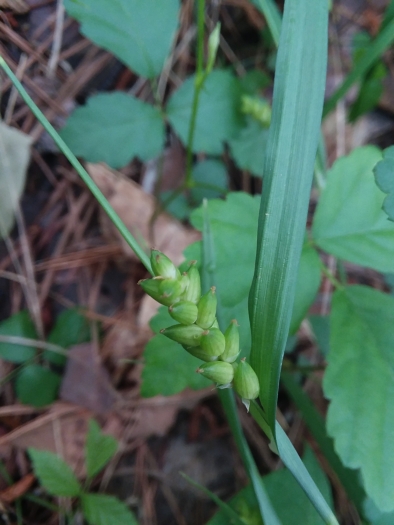Blue Wood Sedge
(Carex flaccosperma)
Blue Wood Sedge (Carex flaccosperma)
/
/

Will McFarland
CC BY 4.0
Image By:
Will McFarland
Recorded By:
Copyright:
CC BY 4.0
Copyright Notice:
Photo by: Will McFarland | License Type: CC BY 4.0 | License URL: http://creativecommons.org/licenses/by/4.0/ | Rights Holder: Will McFarland | Publisher: iNaturalist | Date Created: 2020-04-22T08:14:20-07:00 |


















Estimated Native Range
Summary
Carex flaccosperma, commonly known as Blue Wood Sedge, is an evergreen perennial grass native to moist, open woodlands, and forest edges in the Southeastern USA. It typically grows to a height of 1 foot (0.3 meters) and a width of 0.5-1 feet (0.2-0.3 meters). This sedge forms clumps of narrow, blue-green foliage that add texture and color contrast to garden settings. It is not particularly showy, but its foliage maintains a subtle appeal throughout the year.
Blue Wood Sedge is valued for its ability to thrive in shady, moist conditions where other plants may struggle. It is often used as a ground cover in woodland gardens, shaded borders, and rain gardens due to its preference for wet environments and its deer resistance. While it does best in part shade or full shade, it also requires consistently moist soil with medium to slow drainage. It is not drought-tolerant and may require additional watering during dry periods. Carex flaccosperma is also appreciated for its low maintenance requirements once established. Gardeners should be aware that it can be potentially invasive when grown outside its native range, so it is essential to check local regulations before planting.CC BY-SA 4.0
Blue Wood Sedge is valued for its ability to thrive in shady, moist conditions where other plants may struggle. It is often used as a ground cover in woodland gardens, shaded borders, and rain gardens due to its preference for wet environments and its deer resistance. While it does best in part shade or full shade, it also requires consistently moist soil with medium to slow drainage. It is not drought-tolerant and may require additional watering during dry periods. Carex flaccosperma is also appreciated for its low maintenance requirements once established. Gardeners should be aware that it can be potentially invasive when grown outside its native range, so it is essential to check local regulations before planting.CC BY-SA 4.0
Plant Description
- Plant Type: Grass
- Height: 0.5-1 feet
- Width: 0.5-1 feet
- Growth Rate: Slow
- Flower Color: N/A
- Flowering Season: Spring
- Leaf Retention: Evergreen
Growth Requirements
- Sun: Part Shade, Full Shade
- Water: Low
- Drainage: Medium
Common Uses
Bird Garden, Border Plant, Butterfly Garden, Deer Resistant, Groundcover, Low Maintenance, Rock Garden, Street Planting
Natural Habitat
Moist, open woodlands and forest edges in the Southeastern USA
Other Names
Common Names: Thinfruit Sedge
Scientific Names: , Carex flaccosperma, Carex flaccosperma var. flaccosperma, Carex laxiflora var. mutica, Carex grisea var. mutica, Carex xanthosperma,
GBIF Accepted Name: Carex flaccosperma Dewey